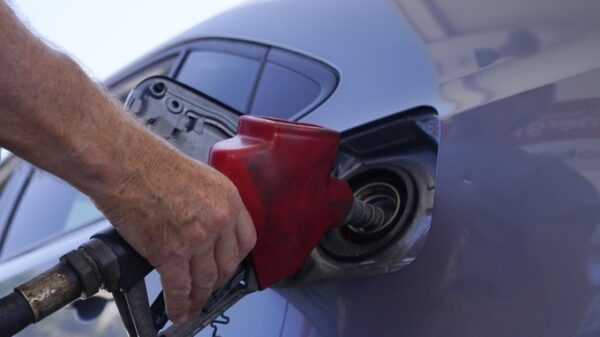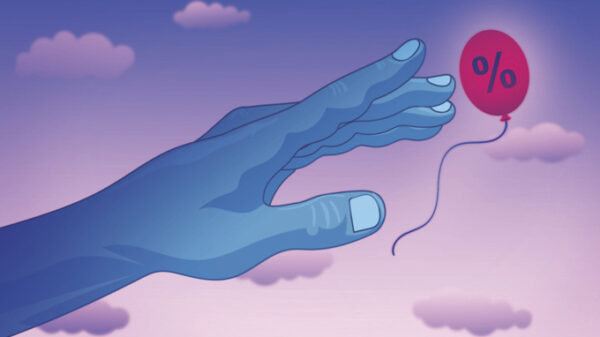A customer pumps gas at an Exxon gas station, Tuesday, May 10, 2022, in Miami. U.S consumers have so far defied higher prices for gas, food, and rent and have been spending more in 2022, providing crucial support to the economy. How long that can continue will be one of the key factors affecting the economy and inflation this year. (AP Photo/Marta Lavandier)
WASHINGTON (AP) — After a year of soaring prices for gas, food and other necessities, inflation may have eased slightly in April from a 40-year high, the first slowdown after seven consecutive months of worsening price increases.
The government is expected to report Wednesday that consumer prices jumped 8.1% last month compared with a year earlier, according to a survey of economists by data provider FactSet. That would be down from the 8.5% year-over-year surge in March, the highest since 1981.
The forecasted drop in annual inflation, if it occurs, would add to other signs that consumer inflation may finally be peaking. Month-to-month price increases are also easing, along with some other inflation gauges.
Yet the April rate would still mark the second-highest inflation in four decades and an ongoing burden for families, especially lower-income Americans. And it would be only a modest step in a likely long and arduous road back to the mild 2% inflation that the Fed has set as its target level. Many economists expect annual price increases to settle into a 5% to 6% range by year’s end, a historically high level that will probably exceed average wage gains.
“It’s too early to declare victory,” said Jose Torres, senior economist at Interactive Brokers. “It’s not going to get any worse, but it’s still at an uncomfortably high level.”
Beyond the financial strain for households, inflation is posing a serious political problem for President Joe Biden and congressional Democrats in the midterm election season, with Republicans arguing that Biden’s $1.9 trillion financial support package last March overheated the economy by flooding it with stimulus checks, enhanced unemployment aid and child tax credit payments.
Biden sought to take the initiative Tuesday and declared inflation “the No. 1 problem facing families today” and “my top domestic priority.”
Biden blamed chronic supply chain snarls related to the swift economic rebound from the pandemic, as well as Russia’s invasion of Ukraine, for igniting inflation. He said his administration will help ease price increases by shrinking the government’s budget deficit and by fostering competition in industries, like meatpacking, that are dominated by a few industry giants.
Still, new disruptions overseas or other unforeseen problems could always send U.S. inflation back up to new highs. If the European Union decides, for example, to cut off Russian oil, gas prices in the United States would likely accelerate. China’s COVID lockdowns are worsening supply problems and hurting growth in the world’s second-biggest economy.
Earlier signs that U.S. inflation might be peaking didn’t last. Price increases decelerated last August and September, suggesting at the time that higher inflation might be temporary, as many economists — and officials at the Federal Reserve — had suggested. But prices shot up again in October, prompting Fed Chair Jerome Powell to start shifting policy toward higher rates.
This time, though, several factors are pointing to an inflation peak. Gas costs, which soared in March after Russia’s invasion of Ukraine, fell on average in April and likely slowed inflation. Used car prices are also expected to have dropped last month. Automakers’ supply chains have unraveled a bit, and new car sales have risen.
Another factor will be how sharp price increases from a year ago affect the new inflation calculations. The prices of many goods spiked last spring as the economy reopened and a surge in demand overwhelmed supplies. But this year, monthly price increases for many goods have been slowing. That may have effect of easing the year-over-year inflation rate.
Furniture costs, for example, had jumped 1.8% just in March 2021 and 2.1% the next month. Yet this March, furniture rose only 0.6%, potentially lowering year-over-year inflation.
Excluding the especially volatile food and energy categories, economists have forecast that so-called core prices jumped 6% in the 12 months ending in April, down from 6.4% in March. That would be the first such slowdown since August. Overall inflation is also expected to have slowed from March to April.
While food and energy have endured some the worst price spikes of the past year, analysts often monitor the core figure to get a sense of underlying inflation. Core inflation also typically rises more slowly than the overall price increases but can also take longer to decline. Rents, for example, are rising at a historically fast pace, and there is little sign of that trend reversing anytime soon.
The unexpected persistence of high inflation has caused the Fed to embark on what may become its fastest series of interest rate increases in 33 years. Last week, the Fed raised its benchmark short-term rate by a half-point, its steepest increase in two decades. And Powell signaled that more such sharp rate hikes are coming.
The Powell Fed is seeking to pull off the notoriously difficult — and risky — task of cooling the economy enough to slow inflation without causing a recession. Economists say such an outcome is possible but unlikely with inflation this high.
In the meantime, by some measures Americans’ wages are rising at the fastest pace in 20 years. Their higher pay enables more people to at least partly keep up with higher prices. But employers typically respond by charging customers more to cover their higher labor costs, which, in turn, heightens inflationary pressures.
Last Friday’s jobs report for April included data on hourly pay that suggested that wage gains were slowing, which, if it continues, could help ease inflation this year.
Copyright 2021 Associated Press. All rights reserved.










































